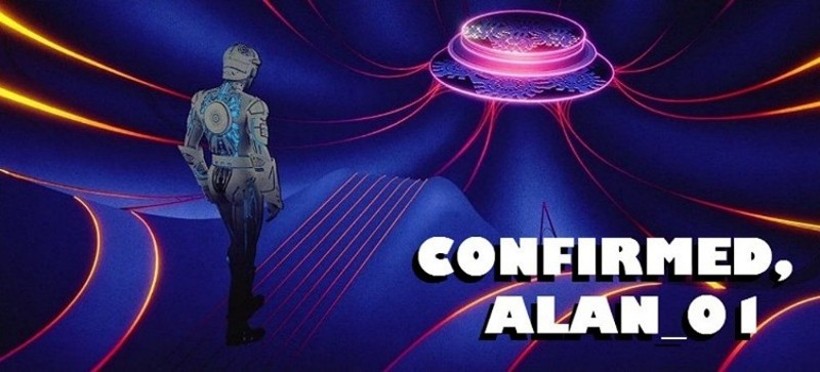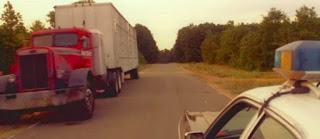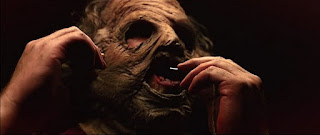"Family's a messy business."
One of the first things you'll p’rolly notice about Texas Chainsaw 3D (2013), Lionsgate and Nu Image's latest reboot of Tobe Hooper's seminal fright flick, The Texas Chain Saw Massacre (1974), is how the word 'massacre' has been dropped in an effort to, perhaps, make it more family friendly -- and I say 'family friendly' because, turns out, that will be a very important ingredient for this latest incarnation.
Kinda like how Kentucky Fried Chicken morphed into KFC because some marketing wonk thought 'fried' denoted something fairly unhealthy and changed everything except what made their product so artery-clogging to bring the customers back. In fact, I'm surprised they didn't just call this latest offering TCM 3D, but I suppose that would have only led to some legal hassles with Turner Classic Movies. And believe me, this film already has enough problems as it is.
Truth told, when I stumbled onto this film while browsing through Netflix Instant, at first, due to the abbreviated title, I had assumed this was most likely The Asylum's knock-off to cash-in on the latest Chain Saw reboot. And seized with an uncontrollable urge to see what THAT shit-show would look like, I immediately pushed play. And, well, hell, look at that, said I. I was wrong. This was, indeed, the reboot, which I watched with ever escalating agog -- agog'd for all the wrong reasons, mind you. Because, Oh, you dumb, stupid movie. Where do I even begin?
First up, as a PSA to all potential screenwriters out there, I'll throw out this question to the class: What is the worst misstep you could possibly make when writing a film about a group of cannibals living in rural Texas who are responsible for the deaths and consumption of god knows how many people? Unless your answer is “Make them the injured party,” I'm sorry, but put down your pencils. You've failed. However: If that was your answer -- Congratulations! You've just spawned the turd-nugget from which this reboot-cum-sequel sprung. Hooray!
And the film does come out a'springin', using a fairly effective montage of the original film to get everyone up to speed; another tactical mistake, in hindsight, because that's a lot to live up to, am I right? Sure, the film will play lip-service to all those infamously brutal kills, but we're talking nth generation carbon copies, here, people.
Anyways, the film begins right where the original ends, with Sally making her escape and reaching the local authorities (-- via original crash-cut footage, some cock-knocking guitar riffs, and a voice-over).
When the sheriff arrives at the Sawyer house, the abandoned semi is still there -- though no sign of the Hitchhiker's flattened corpse is evident, but then I'm sure the Sawyers never overlooked any kind of roadkill to throw into the stew-pot. He also spies several others, several others we've never met, armed and barricading themselves inside the house. Where did all these other people come from? Apparently, they're kin, called in to help defend the family homestead. That might not make much sense, but their presence is necessary, otherwise we wouldn't have the baby.
Baby?!, you ask. Yeah, we'll get to that plot contrivance in a sec. For now, it's important to note Sheriff Hooper (Barry) is in a negotiating mood and only wants the boy -- a/k/a Leatherface, or Jed, as he's referred to in this film, to surrender quietly. Apparently, Sally was too traumatized to finger the others for the kidnapping and assault but only pointed an accusing finger at the guy with the chainsaw for murdering her friends. That, or our trio of scriptwriters either never watched the original, or forgot, or hoped we wouldn't remember these piddling details.
The Old Man (-- not James Siedow, but a reasonable facsimile,) seems ready to capitulate to these demands but things quickly get out of hand when a rowdy lynch mob of rednecks and hayseeds arrive, led by a local hard-ass named Hartman (Rae). Seems the locals were wary of the Sawyers' seedy culinary enterprises and will turn a blind-eye no longer. Tempers quickly flare, shots are fired, Molotov cocktails are thrown, and the Sawyer house soon becomes a raging inferno, trapping and killing everyone inside, save for two; a mother and her infant daughter.
But they're found by a surly bumpkin amongst the graveyard of stolen cars of all those people plucked and BBQ'd over the years, who quickly kills the woman and turns the baby over to his own barren wife to raise as their own. And before we abandon this prologue, we should note that even though his charred chainsaw was found, it was impossible to identify any of the burnt remains as actually being Jed Sawyer -- he typed stupidly. Shit, I mean, He typed ominously...
Now jump ahead some 20-years, where we catch-up with Heather Miller (Daddario), who is now all grown up and working as -- wait for it -- a meat cutter at a grocery store. And if that kind of blunt foreshadowing doesn't clue you in as to where all of this is going, congratulations again for not being a jaded old fart-knocker who has seen one too many of these damnable things.
And so, left with a film I hope will either surprise me (doubtful) or at least be worth the trip (forgive me for not holding my breath), the plot proper gets moving when Heather comes into a sizable inheritance from a grandmother she never knew she had, which soon finds her, her boyfriend, Ryan (Songz), her best friend, Nikki (Raymonde), and her beau, Kenny (Malicki-Sanchez), packed into a familiar looking VW-microbus and roaming around the back-roads of Texas. They even manage to pick themselves up a dubious hitchhiker (Sipos) before arriving at the ancestral mansion of Verna Carson -- whose maiden name, we find out, thanks to a handy headstone, was Sawyer.
The first sign of trouble is when Farnsworth (Riehl), the executor of the Carson estate, refuses to set foot on the property, turning over a ridiculously massive set of keys, papers, and a letter Heather is direly instructed to read immediately. Of course, this letter is summarily ignored to explore the posh pad instead. And when the others head into town for some vittles, the hitchhiker hangs back and ransacks the place, using those keys to poke into every nook, cranny and, eventually, the basement via a secret passage, where he finds a familiar looking metal door (-- which sticks out rather ridiculously, when you get right down to it), which refuses to open. Never fear, what's on the other side soon reveals himself, sledgehammer in hand, and makes with the *whack* *thud* *splat*.
Meanwhile, in town, Heather gets the standard 'we don't like outsiders' vibe off of the locals, except for Carl (Eastwood), a too friendly deputy, and Hartman, now the mayor of Wherever the Hell We Are, who is flatly rebuffed when he offers to buy the old Carson place.
Returning to the house, they discover what the late hitchhiker had been up to, which is pretty much ignored because it's time to par-tay. And while Ryan and Nikki head off to the barn to continue their covert affair, Kenny manages to find the basement and gets himself killed rather gruesomely. Blissfully unaware of all this, Heather explores the upper floors of the mansion, stumbles upon a few more plot contrivances (-- most notably the S-shaped pendant worn by all the Sawyer women in several portraits), until eventually finding the exhumed corpse of her benefactor awaiting in the master bedroom. Yoinks!
The chainsaw kinda hits the fan from there, with Heather the only one escaping Leatherface's rampage in one piece after successfully evading him by heading toward the apparent safety in numbers of a local carnival, where she is rescued by Deputy Do-RIght. (+5 intelligence points on the script, which brings the score to -546. Woo.)
Taken into protective custody, things stay firmly on the plot contrivance path as Heather is left alone with a big, convenient box of evidence about the Sawyer family massacre, including a very prominent newspaper clipping and photo which shows all the participants of said massacre -- Mayor McCranky and her “parents” etc., which she sifts through while Sheriff Hooper and Mayor McCranky kill some screen time watching another deputy follow a blood trail into the Carson house via a transmitting smartphone with some amazing reception and a 10,000-Watt spotlight app.
Stumbling into the basement, Deputy Dipstick recreates the deep-freeze discovery from the original and commits some friendly-fire atrocities before getting himself killed and skinned, which gives us the most pleasant opportunity of watching Jed (Yeager) stitch a new mask onto his face and dress up like Mae West in Sextette (1977). Thank you, movie.
Okay, now, already teetering on the brink, here's where the film really shits the bed as far as I'm concerned as Heather, incensed over the death of her real family, escapes police custody and tracks down that estate lawyer, who reveals that Verna was the last of the Sawyers (-- well, third to last but whatever), who hired him to find Heather so she could come home and take over her role as caretaker of Jed, who was hidden away in the basement these many years.
With that plot-dump out of the way, she's then ambushed and captured by Deputy Do-RIght, who turns out to be the son of Mayor McCranky, who is bound and determined to end the Sawyer line once and for all.
Taken to the old slaughter house for proper disposal, luckily for Heather, Jed, who was listening in on the dead deputy's radio, arms up, knots up his tie, and heads over to join in on the fun. Finding a trussed up and strangely abandoned Heather, our gibbering maniac prepares to dismember her until noticing a birthmark on his victim's chest. Only it's not a birthmark, see, but a scar acquired when her real mother's S-pendant seared into her while escaping the fire.
Realizing she's family, Jed frees her; but their reunion is short-lived when Hartman shows up. And then, quite stupidly, the tables are turned so Jed becomes the degenerate in distress for Heather to save. Once that's done, with a quip that left me mentally groaning for hours and hours, Leatherface pulps Hartman in a meat-grinder while Heather AND Sheriff Hooper watch approvingly.
Then, to add insult to injury, with a nod and a simple demand that Heather clean up the mess, Hooper leaves them alone and un-arrested. No, no, see, Hartman was really the bad guy, see. He was the real monster, see. And Jed was just taking revenge on those who killed his family, see. The Sawyers were the real victims, see. It doesn't matter that Jed and his kin have killed and eaten hundreds of innocent people, see, because family is family, and the family that slays together, stays together.
... And so, Heather finally reads that letter, explaining everything, dons her pendant, symbolically taking on the burden of her heritage without a second thought for her bestest friends, whose remains probably aren't even cold yet somewhere below; and then we wrap things up with Jed re-burying his old caretaker before returning to his spider-hole, while his new custodian moves to make him a midday snack after a hard day’s slaughter. (I'll bet that Kenny tastes like chicken.)
Pardon me, but, *pffffffffffffttttt* ... Gahd my head hurts just thinking about the overall plot of this thing, which asks us to gloss over a lot and accept some extremely ignorant and asinine motivations to make it work. Stupid I can handle, but Texas Chainsaw 3D was just plain dumb.
And it's all on the script, credited to Adam Marcus, Debra Sullivan, and Kirsten Elms. I'm a little baffled that it took three people to cop everything that was terrible about Rob Zombie's House of a Thousand Corpses (2003) and The Devils Rejects (2005) and then threw in every misguided and overwrought 'it's all about the family' liberties taken in Jan de Bont's version of The Haunting (1999). The grue FX stands and delivers -- even though it had to be massively cut to escape its initial NC-17 rating, but it's just not enough to overcompensate for the five-car plot contrivance pile-up. Not even close.
Shot with a savage eye to cash-in on the 3D boom of the period of its release, meaning there's a ton of crap being thrown at you from the very beginning -- be it blade or dismembered appendage, apparently, this thing had the blessing of Tobe Hooper and Kim Henkel, who served as producers. Fledgling director John Luessenhop and his cast do the best they can with it. Alexandra Daddario is so gorgeous, and I can’t even even with those eyes of hers. She runs circles around the rest of the cast and deserves better. The only other stand-out is Paul Rae as the local hardass. And, holy crap, does Scott Eastwood look like his dad. Gunnar Hansen and Marylin Burns showed up in a couple of glorified cameos. Bill Moseley was also in there somewhere but I failed to spot him until the IMDB told me it was him who played the Old Man.
Ya know, since they first hit the screen, it’s always been a running dogfight between this franchise and Halloween’s as to which collection of sequels and reboots have done the most damage and disservice to their original movies, with The Howling (1981) playing the sleeper and JAWS (1975), Friday the 13th (1980) and A Nightmare on Elm Street (1984) not too far behind. And though Texas Chainsaw 3D did a lot to widen that gap, there is some consolation in that its plot-problems of egregiously misplaced sympathy aren't quite as detestable as the Illuminati-induced horseshit of Texas Chainsaw Massacre: the Next Generation (1994). So there's that, at least -- but not much else.
Originally posted on January 12, 2014 at Micro-Brewed Reviews.
Texas Chainsaw 3D (2013) Leatherface Productions :: Lionsgate :: Mainline Pictures :: Millennium Films :: Nu Image Films :: Twisted Chainsaw Pictures / EP: Mark Burg, Christa Campbell, Danny Dimbort, Lati Grobman, Kim Henkel, Tobe Hooper, Robert Kuhn, Avi Lerner / P: Carl Mazzocone / AP: T. Justin Ross / D: John Luessenhop / W: Adam Marcus, Debra Sullivan, Kirsten Elms / C: Anastas N. Michos / E: Randy Bricker / M: John Frizzell / S: Alexandra Daddario, Trey Songz, Tania Raymonde, Keram Malicki-Sánchez, Scott Eastwood, Thom Barry, Paul Rae, Dan Yeager





















































